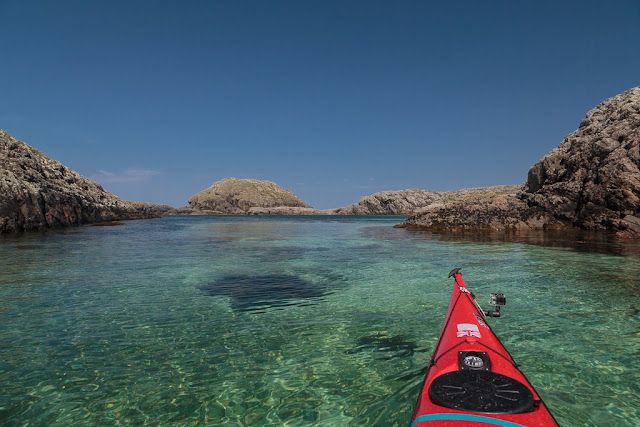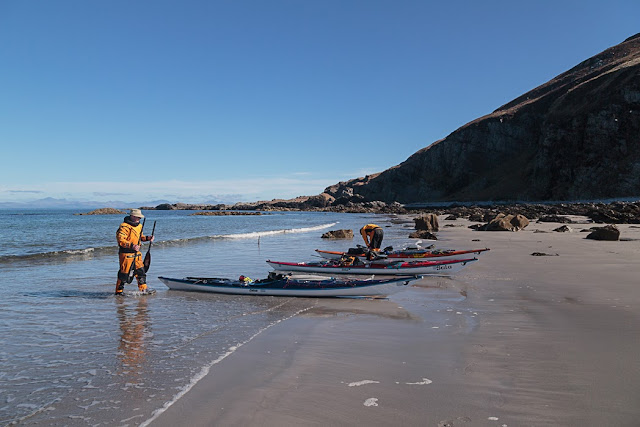We paddled north across the expanse of Camas Cuil an t-Saimh on the west coast of Iona. This is commonly translated as "bay (or beach) at the back of the ocean" which sounds delightfully romantic and tourist guides love it. However, Roddy (who was the last native Gaelic speaker in our family) said it was much more likely to be "bay with a stink at its back". He said the Gaels were not known for using much romance or imagination in naming places. The word "saimh" is much more often used to mean "stink" than "sea" which is an unusual use of the word. Roddy also said if it was used to mean sea it would be used to describe a fishy smelling sea. Given the huge piles of rotting seaweed at the back of the bays I have a feeling Roddy is right.
We all spotted the splash of white sand at Port Pollarain (Port of the Dunlin) and it looked a great place to stop for luncheon, indeed I had stopped here for such in 2007. However, based on past experience, I had other ideas. I thought I could do better.
So I led the way through a maze of skerries to the...
...simply stunning Port Ban (white port). Despite the beauty of the surroundings, I was initially somewhat disappointed. On my last visit...
...this is what we found. Our caddies had travelled ahead, by a variety of means, and assembled our social and refreshment tents prior to our arrival on this pristine cockleshell sand beach. Why, they had even scoured far and wide for some small pieces of driftwood just so that we might enjoy a little late night incendiary activity.
On this day our support team had badly let us down and as we paddled one by...
...one over crystal clear turquoise water we had to content ourselves not with tents of...
...pleasure but with a totally...
...empty beach!!! Oh the hardship!
At first we wandered about somewhat lost but we soon settled down to enjoy a view of...
...unparalleled beauty. As the others tucked into their sandwiches (rather than the hoped for canapes) I even went for a short swim. No wonder St Columba chose Iona, this really is Heaven on Earth.
PS Note the crescent of stinky seaweed at the back of the bay!
Imagine you are at the edge of the sea on a day when it is difficult to say where the land ends and the sea begins and where the sea ends and the sky begins. Sea kayaking lets you explore these and your own boundaries and broadens your horizons. Sea kayaking is the new mountaineering.
Showing posts sorted by relevance for query columba. Sort by date Show all posts
Showing posts sorted by relevance for query columba. Sort by date Show all posts
Wednesday, June 22, 2016
Thursday, May 13, 2010
Egalitarian cruising on the Clyde
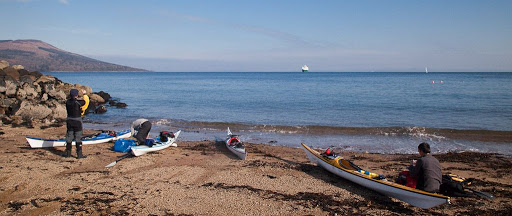
After arrival at Brodick, we trollied the kayaks off the ferry and turned hard left at the top of the ramp. This took us to a little beach of reddish Arran sand.
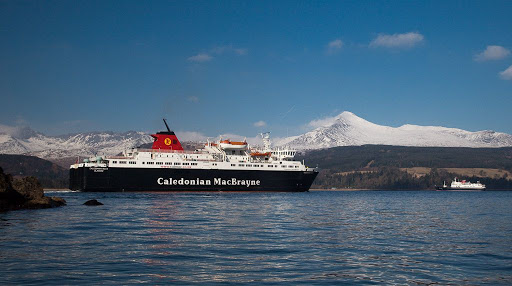
We were on the water quickly, almost as soon as the MV Caledonian Isles took to turn around.
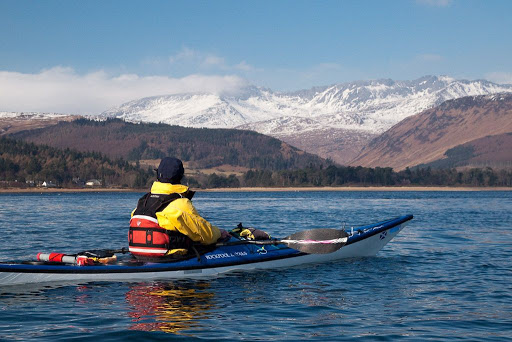
We launched into light winds and flat water which was in total contrast yo the conditions on the far side of the Clyde. We had not only made the right navigational decision, we had enjoyed a nutritious breakfast on board the ferry!
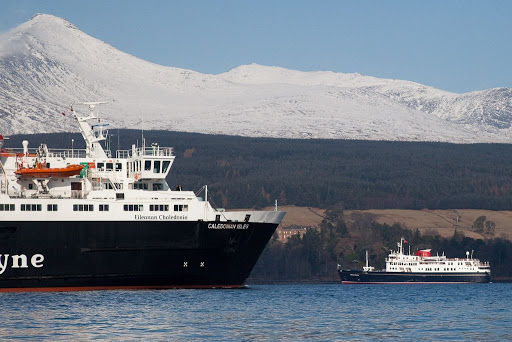
Beyond the MV Caledonian Isles we spotted the MV Hebridean Princess at anchor on the other side of Brodick Bay.
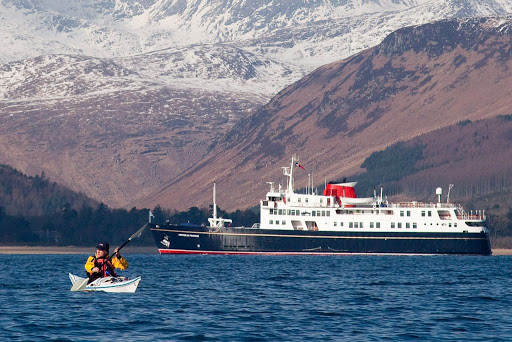
The MV Hebridean Princess is a former CalMac ferry that has been converted into a small luxury cruise liner. Don't expect to get much change from £2,500 per week in the cheap cabins. However, I understand the cuisine is in a different league to the fare we enjoy on the Arran ferry! Note the freshly painted navy blue hull which was previously black. Hebridean Princess has just undergone a major refit and this was her first outing in her smart new livery.
She was built in 1964 and, as MV Columba, she served on many routes out of Oban. Latterly she was a relief vessel for more modern RoRo ferries. When she was sold to Hebridean Island Cruises in 1988, she was the last hoist loading ferry in CalMac's Western Isles fleet. Originally she took 50 cars and 870 passengers. In her current role she carries only 49 passengers.
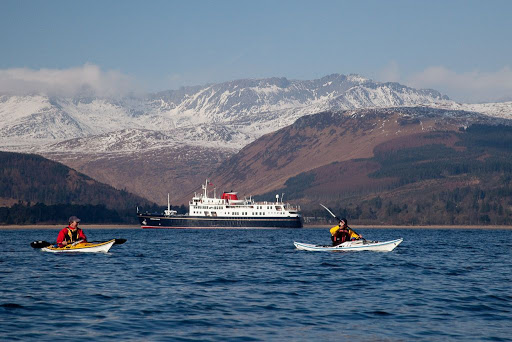
Cruising on the Clyde can be enjoyed by rich and poor, it's a very egalitarian activity.
We were looking forward to our yummy SPAM sandwiches, here is what those cruising on Hebridean Princess could look forward to:
Fresh Hand Dived Scallops
With a Thai green curry sauce
Isle of Mull Cheddar Cheese and Red Onion Tart
Carrot and Orange Soup
——‡——
Fresh Fillet of Sea Bream, Savoury Pancake
With red pepper dressing and sautéed greens
Guinea Fowl with a Herb Mash and Ribbons of Courgette
——‡——
Chocolate Nemesis with Crème Chantilly
And mint syrup
Strawberry Pavlova with a Duo of Coulis
Selection of Cheeses
——‡——
Coffee and Petits-fours
Will be served in the Tiree Lounge, the Conservatory and the Look Out Lounge
YUM YUM YUM!
Sunday, June 03, 2007
Walking among the stones of history in the monastery of Hinba.

The monastery on Eileach na Naoimh was founded by St Brendan of Clonfert in AD 542. At that time the Garvellachs were known as Hinba or the Isles of the Sea.

St Brendan was born in County Kerry in Ireland in AD 484. In addition to his Christian faith he was a great seafarer and was also known as Brendan the Navigator. He left on a seven year voyage to discover the fabled Celtic island of Tir nan Og (or Land of Perpetual Youth). Some say he discovered North America but what is certain is that he came here to Hinba and founded a monastery. Some buildings are beehive cells similar to those found at Skellig Michael in Ireland. Even St Columba, came to Hinba for some peace and meditation and to escape from the bustle of his monastery on Iona. St Brendan's influence is also remembered in other local place names such as the Kilbrannan Sound.
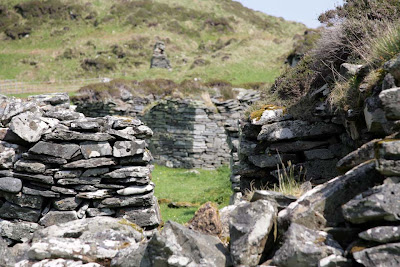
The island has been uninhabited for a thousand years since the Vikings sacked the monastery. Today, even in the spring sunshine, wandering among the ancient stones of Hinba, you are surrounded by echos and ghosts of the past.

Ancient grave stones protrude above the encroaching mosses and grass. Their only markings are the patterns of lichens, which grow in abundance in the clean air. The identities of the occupants of the graves below are unknown but they were our ancestors and like us they were attracted to this necklace of islands to escape the everyday world. Unfortunately for them, 500 years of peaceful meditation were ended by a change in the outside world; the arrival of the Vikings.
To this day St Brendan is the patron saint of seafarers and (dare I say it?) sea kayakers.
Tuesday, November 18, 2014
For richer and poorer in the Hunterston Channel.
I have not paddled on the Clyde since my mother died in July and as Sunday 16th November was forecast to be such a beautiful day I decided it was time to get back out. A trip to Little Cumbrae, Bute and The Eileans from Largs seemed in order so after a few texts I met up with regular paddling buddy Phil but also Andrew, Colin McM, Colin R and Maurice, all from my old home town of Ayr.
We used the ebb to head down the the Hunterston channel past...
the Hun 5 starboard channel buoy,...
...the coal and ore terminal and...
...the "robbing the poor to pay the rich" offshore wind turbine test bed. This so called green scheme is funded by a tax on every citizen's power bill and subsidises multinational companies and land owners to build these expensive, inefficient and resource greedy monsters. There is nothing renewable about this industry which damages the environment and the sea bed during both construction, running not to mention disposal after their short working lives have expired.
As we drove into Largs, the Kelburn and West Kilbride windmills were all turning. Do you notice how much wind there was? They were being turned by electricity generated by the Hunterston B nuclear power station, which is just to the right of this photo. It is a common public relations stunt when it's calm. Then when it is windy they don't turn because they break or go on fire like this one at West Kilbride. What is needed is another nuclear power station station but we are unlikely to get one in Scotland while the Nationalists hold power in Edinburgh, as they are in bed with the Greens. Anyway, back to the test bed, these monster turbines are prototypes for thousands which are planned for off the west coast of the Hebrides. I really doubt the politicians and the industrialists have a clue about how much it will cost to build and maintain them in the harsh conditions out there...
Land based wind factories also have problems. They are destroying the wilderness across Scotland and developers and land owners are getting away with it because most politicians and "green" city dwellers (who all leave their lights and chargers on) don't give a monkey's cuss about the countryside.
Wind farms represent the biggest redistribution of wealth from the poor to the rich in this country since the Norman invasion of 1066. (Even that proto-nationalist, Robert the Bruce, was a Norman!)
Talking of the rich, this lovely little ship, the MV Hebridean Princess, was anchored in Millport Bay. She was built in 1964 in Aberdeen and as MV Columba served as a ferry on the Inner and Outer Hebrides for what would become Calmac. When she was retired in 1988 she was the last Calmac ferry to load cars with a hoist. She was bought by Hebridean Island Cruises who operate her as a luxury cruise ship for 50 passengers. A double cabin in peak season will cost you well over £1000 per night. Since the Royal Yacht Britannia was retired, the Queen has chartered the Hebridean Princess several times for Royal cruise parties. I would love to go on a week's cruise on her but don't have the spare cash. I had better go and switch the heating off and start saving.
We used the ebb to head down the the Hunterston channel past...
the Hun 5 starboard channel buoy,...
...the coal and ore terminal and...
...the "robbing the poor to pay the rich" offshore wind turbine test bed. This so called green scheme is funded by a tax on every citizen's power bill and subsidises multinational companies and land owners to build these expensive, inefficient and resource greedy monsters. There is nothing renewable about this industry which damages the environment and the sea bed during both construction, running not to mention disposal after their short working lives have expired.
As we drove into Largs, the Kelburn and West Kilbride windmills were all turning. Do you notice how much wind there was? They were being turned by electricity generated by the Hunterston B nuclear power station, which is just to the right of this photo. It is a common public relations stunt when it's calm. Then when it is windy they don't turn because they break or go on fire like this one at West Kilbride. What is needed is another nuclear power station station but we are unlikely to get one in Scotland while the Nationalists hold power in Edinburgh, as they are in bed with the Greens. Anyway, back to the test bed, these monster turbines are prototypes for thousands which are planned for off the west coast of the Hebrides. I really doubt the politicians and the industrialists have a clue about how much it will cost to build and maintain them in the harsh conditions out there...
Land based wind factories also have problems. They are destroying the wilderness across Scotland and developers and land owners are getting away with it because most politicians and "green" city dwellers (who all leave their lights and chargers on) don't give a monkey's cuss about the countryside.
Wind farms represent the biggest redistribution of wealth from the poor to the rich in this country since the Norman invasion of 1066. (Even that proto-nationalist, Robert the Bruce, was a Norman!)
Talking of the rich, this lovely little ship, the MV Hebridean Princess, was anchored in Millport Bay. She was built in 1964 in Aberdeen and as MV Columba served as a ferry on the Inner and Outer Hebrides for what would become Calmac. When she was retired in 1988 she was the last Calmac ferry to load cars with a hoist. She was bought by Hebridean Island Cruises who operate her as a luxury cruise ship for 50 passengers. A double cabin in peak season will cost you well over £1000 per night. Since the Royal Yacht Britannia was retired, the Queen has chartered the Hebridean Princess several times for Royal cruise parties. I would love to go on a week's cruise on her but don't have the spare cash. I had better go and switch the heating off and start saving.
Saturday, April 30, 2016
Dead beat and washed up at Corpach Bay, Jura.
Well in need of a break, we were delighted to find a breach in the NW cliffs of Jura at Corpach Bay.
The name tells a little of the history of this lonely spot. "Corpach" means place of the corpse and it was here that the people of Kintyre, Jura and Islay would leave the corpses of the deceased if it was too stormy to cross to the burial isles of Oronsay and Iona. Caves near Ruantallain to the SW were mostly used for the passage to Oronsay to the south of Colonsay. The caves at Corpach Bay were used for the passage to Iona. One of the largest is called Corpach Challuim-chille which loosely translated means place of the the corpse of the church of St Columba.
Anyway after our hard paddle through the Corryvreckan the previous day and our early start, we were feeling dead beat and so where better too rest than Corpach Bay?
After swapping paddles over, (we are currently comparative testing the excellent new VE Voyager paddle) we...
...unpacked our second breakfast things...
...and made our way up the beach.
Corpach Bay was easy to land on when we visited but it is often exposed to heavy surf and I would not like to meet these boulders in a loaded boat being driven in by surf.
We could hardly belive how quickly the swell had dropped as less than 48 hours previously, the ferries were not running.
I thought this boulder buried in the sand looked a bit like a misshapen skull.
Anyway, the sky was blue, the sun was shining and what a spot...
...we had found for second breakfast. Ian and briefly considered a quick swim in the sea as a wash up but a chill wind from the north had picked up. We were not the only ones to be washed up on Corpach Bay...
...these lobster pots and cobbles from the beach had been washed up by winter storms and were now left lying well inland from the beach.
The name tells a little of the history of this lonely spot. "Corpach" means place of the corpse and it was here that the people of Kintyre, Jura and Islay would leave the corpses of the deceased if it was too stormy to cross to the burial isles of Oronsay and Iona. Caves near Ruantallain to the SW were mostly used for the passage to Oronsay to the south of Colonsay. The caves at Corpach Bay were used for the passage to Iona. One of the largest is called Corpach Challuim-chille which loosely translated means place of the the corpse of the church of St Columba.
Anyway after our hard paddle through the Corryvreckan the previous day and our early start, we were feeling dead beat and so where better too rest than Corpach Bay?
After swapping paddles over, (we are currently comparative testing the excellent new VE Voyager paddle) we...
...unpacked our second breakfast things...
...and made our way up the beach.
Corpach Bay was easy to land on when we visited but it is often exposed to heavy surf and I would not like to meet these boulders in a loaded boat being driven in by surf.
We could hardly belive how quickly the swell had dropped as less than 48 hours previously, the ferries were not running.
I thought this boulder buried in the sand looked a bit like a misshapen skull.
Anyway, the sky was blue, the sun was shining and what a spot...
...we had found for second breakfast. Ian and briefly considered a quick swim in the sea as a wash up but a chill wind from the north had picked up. We were not the only ones to be washed up on Corpach Bay...
...these lobster pots and cobbles from the beach had been washed up by winter storms and were now left lying well inland from the beach.
Sunday, December 31, 2017
Our sea kayaking pilgrimage comes to a peaceful end in Oronsay Priory
As we made our way up from the beach David had a spring in his step which was quite unlike thast of his first visit some years ago. I had told him that we were going to visit the Priory. He visibly paled before he said "Is that wise? They'll never let us out, we'll need to go into rehab and walk the twelve steps!"
As we made our way over the machair towards...
...Oronsay House we were intercepted by the RSPB warden. Straight away I asked how his nettle patches were growing? He then knew that we were aware that Oronsay was an important reserve for corncrakes. He told us that there were presently three calling males on the island but unfortunately we did not hear them on our visit. Another reason the wardens rush up to meet visiting sea kayakers is that they do not want you to camp on the island. My friend Tony stood his ground when approached by a previous warden several years ago. He was camped on the east of the island well away from areas used by corncrakes and choughs, which are the species the RSPB is most interested in.
Under the terms of the Land Reform Act (Scotland) you can visit and camp on Oronsay provided you avoid disturbing the birds (or other wildlife). The RSPB website still encourages visitors to visit their other reserve Loch Gruinart on Islay instead: "This site is one of several that due to its size, location and/or conservation sensitivity is not capable of accommodating large numbers of visitors (unless stated). Where possible, we have indicated the nearest equivalent RSPB nature reserve (Loch Gruinart) suitable for visiting."
Fortunately, they now have a rider at the bottom of the page which recognises your legal right to access the island: "This does not affect any statutory rights of access under the Countryside and Rights of Way Act or Land Reform (Scotland) Act legislation".
I joined the RSPB in 1973 when I started work as a ranger/naturalist with the National Trust for Scotland. Although I was a member for several decades, I left when it became clear their aim was to restrict public access to their reserve land.
Anyway the RSPB do not own Oronsay. The island belongs to a delightful American lady, Mrs Colburn, who we have found to be most welcoming of visitors. Indeed on our last visit we met her on the beach and helped her clear up plastic flotsam and jetsam.
As we passed her lovely house on the way to the Priory she waved to us from the window.
Oronsay Priory is situated where the machair abuts the foot of a rocky crag (where you maybe lucky and see choughs). A deep sense of peace pervades this place and it is no wonder that a religious settlement was set up here, far from the turmoil, violence, warfare and lawlessness that plagued most of Scotland throughout the Dark Ages and Mediaeval Times. These buildings date from the mid 1300's but there may have been a chapel here since St Columba's time. The Priory was founded by the Lords of the Isles and became a centre for religious sculpture until about 1500.
The sandy machair soil of Oronsay lent itself to easy grave digging and there were no wolves on Oronsay to dig up recently buried corpses. So Oronsay became both a place of religious pilgrimage and a final resting place. Many of those interred here were former pilgrims or residents of Argyll on the mainland or like this recent grave, drowned sailors whose bodies were washed ashore. You can read more about some interesting graves on Oronsay in this post from our previous visit.
Some say St Oran gave his name to Oronsay but I rather doubt this as Oronsay is quite a common name for tidal islands on the west coast. It comes from the Old Norse and means "island of the ebb tide" which is exactly what Oronsay is. You can walk to it from neighbouring Colonsay at low tide.
Undoubtedly the most impressive features of the graveyard are its two standing crosses. This is the Great Cross of Oronsay, which stands inconspicuously against the farm buildings at the back of the Priory graveyard. It is finely carved on both sides and is thought to have come from Iona.
Although it has withstood over 5 centuries of weathering, you can still see how finely the east face of the cross was carved.
The west face of the cross is also finely carved and at...
...its base is a Latin inscription. It was carved for Malcolm MacDuffie, the Lord of Colonsay, some time after 1472 and erected before 1500.
Another interesting, but older, cross stands on a little knoll to the east of the Priory. In 1881 just the shaft was standing and the present head of the cross lay on the ground beside it.
...cloistered courtyard. Someone was lying in peaceful contemplation...
...it turned out to be Sam who, without a sail, must have been quite exhausted keeping up with the paddle sailors who had enjoyed a fair wind on the long crossing from Jura.
...to David's great relief was not locked.
As we made our way back into the graveyard we passed below...
..the great east window of the chapel which must have been magnificent when it was filled with stained glass.
As we took our final steps at the end of our personal pilgrimage to the Priory on Oronsay we reflected on those who had led their lives here and kept human decency, hope and faith alive through the darkest centuries of Scotland's bloody past. Whether or not you are Christian, or even of any religious persuasion, I suspect that if you ever visit this place, you would set off on your road home inspired to help in your own way to make the World a better and more peaceful place for all its inhabitants.
Far from the Peace of Oronsay and away to the east, beyond the Paps of Jura, lie the lands that inspired Christianity, Judaism and Islam. It is a sad paradox that many lives in those lands that were at one time the cradle of civilisation are currently blighted by senseless violence and destruction.
You can read Ian's account here.
As we made our way over the machair towards...
...Oronsay House we were intercepted by the RSPB warden. Straight away I asked how his nettle patches were growing? He then knew that we were aware that Oronsay was an important reserve for corncrakes. He told us that there were presently three calling males on the island but unfortunately we did not hear them on our visit. Another reason the wardens rush up to meet visiting sea kayakers is that they do not want you to camp on the island. My friend Tony stood his ground when approached by a previous warden several years ago. He was camped on the east of the island well away from areas used by corncrakes and choughs, which are the species the RSPB is most interested in.
Under the terms of the Land Reform Act (Scotland) you can visit and camp on Oronsay provided you avoid disturbing the birds (or other wildlife). The RSPB website still encourages visitors to visit their other reserve Loch Gruinart on Islay instead: "This site is one of several that due to its size, location and/or conservation sensitivity is not capable of accommodating large numbers of visitors (unless stated). Where possible, we have indicated the nearest equivalent RSPB nature reserve (Loch Gruinart) suitable for visiting."
Fortunately, they now have a rider at the bottom of the page which recognises your legal right to access the island: "This does not affect any statutory rights of access under the Countryside and Rights of Way Act or Land Reform (Scotland) Act legislation".
I joined the RSPB in 1973 when I started work as a ranger/naturalist with the National Trust for Scotland. Although I was a member for several decades, I left when it became clear their aim was to restrict public access to their reserve land.
Anyway the RSPB do not own Oronsay. The island belongs to a delightful American lady, Mrs Colburn, who we have found to be most welcoming of visitors. Indeed on our last visit we met her on the beach and helped her clear up plastic flotsam and jetsam.
As we passed her lovely house on the way to the Priory she waved to us from the window.
Oronsay Priory is situated where the machair abuts the foot of a rocky crag (where you maybe lucky and see choughs). A deep sense of peace pervades this place and it is no wonder that a religious settlement was set up here, far from the turmoil, violence, warfare and lawlessness that plagued most of Scotland throughout the Dark Ages and Mediaeval Times. These buildings date from the mid 1300's but there may have been a chapel here since St Columba's time. The Priory was founded by the Lords of the Isles and became a centre for religious sculpture until about 1500.
The sandy machair soil of Oronsay lent itself to easy grave digging and there were no wolves on Oronsay to dig up recently buried corpses. So Oronsay became both a place of religious pilgrimage and a final resting place. Many of those interred here were former pilgrims or residents of Argyll on the mainland or like this recent grave, drowned sailors whose bodies were washed ashore. You can read more about some interesting graves on Oronsay in this post from our previous visit.
Some say St Oran gave his name to Oronsay but I rather doubt this as Oronsay is quite a common name for tidal islands on the west coast. It comes from the Old Norse and means "island of the ebb tide" which is exactly what Oronsay is. You can walk to it from neighbouring Colonsay at low tide.
Undoubtedly the most impressive features of the graveyard are its two standing crosses. This is the Great Cross of Oronsay, which stands inconspicuously against the farm buildings at the back of the Priory graveyard. It is finely carved on both sides and is thought to have come from Iona.
The west face of the cross is also finely carved and at...
...its base is a Latin inscription. It was carved for Malcolm MacDuffie, the Lord of Colonsay, some time after 1472 and erected before 1500.
+HEC EST CR/UX COLINI F/ILII CRISTI/NI M(EIC)DUFACI
'This is the cross of Colinus (Malcolm), son of Christinus MacDuffie
Another interesting, but older, cross stands on a little knoll to the east of the Priory. In 1881 just the shaft was standing and the present head of the cross lay on the ground beside it.
There is some doubt as to whether this is the original head of the cross but it has now been replaced atop the shaft.
It is decorated by a rather portly and smiling figure. Perhaps life was good here when the cross was carved.
The Priory is one of the best preserved medieval religious buildings in Scotland. It was too remote to be destroyed in the Reformation, as were many of its more accessible, contemporary religious buildings. We entered the interior of the Priory to find ourselves in a...
...cloistered courtyard. Someone was lying in peaceful contemplation...
...it turned out to be Sam who, without a sail, must have been quite exhausted keeping up with the paddle sailors who had enjoyed a fair wind on the long crossing from Jura.
Like pilgrims of old, I think all of us particularly appreciated our visit to this special place because of the effort it had taken to get here. We left Sam to his well deserved rest and made our way to the back door of the Priory which...
As we made our way back into the graveyard we passed below...
..the great east window of the chapel which must have been magnificent when it was filled with stained glass.
As we took our final steps at the end of our personal pilgrimage to the Priory on Oronsay we reflected on those who had led their lives here and kept human decency, hope and faith alive through the darkest centuries of Scotland's bloody past. Whether or not you are Christian, or even of any religious persuasion, I suspect that if you ever visit this place, you would set off on your road home inspired to help in your own way to make the World a better and more peaceful place for all its inhabitants.
Far from the Peace of Oronsay and away to the east, beyond the Paps of Jura, lie the lands that inspired Christianity, Judaism and Islam. It is a sad paradox that many lives in those lands that were at one time the cradle of civilisation are currently blighted by senseless violence and destruction.
You can read Ian's account here.

